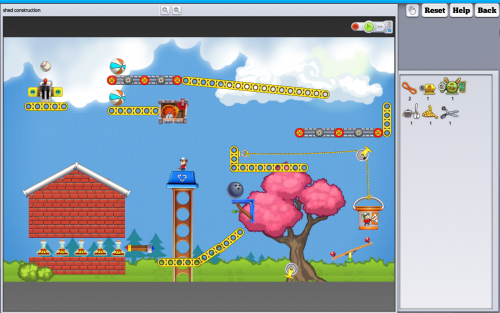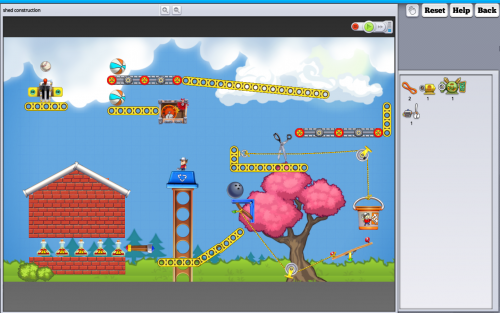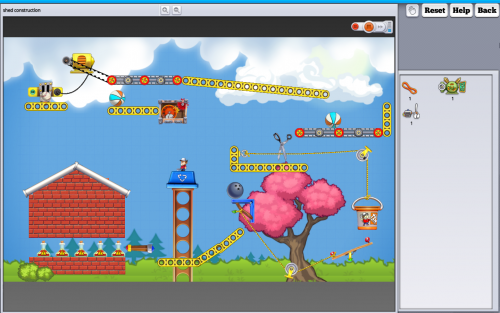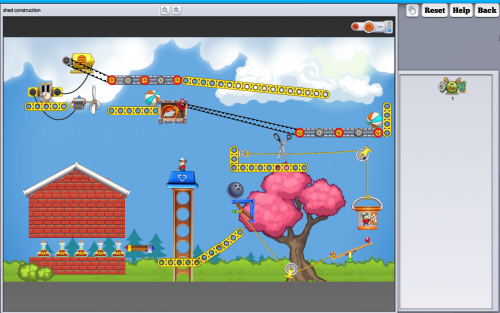Difference between revisions of "Puzzle Building Best Practices"
(→Overview) |
(→Puzzle Walkthrough) |
||
| (5 intermediate revisions by the same user not shown) | |||
| Line 13: | Line 13: | ||
*'''Help the player get started:''' It's no fun for a player to have absolutely no idea where to start. There should be one obvious thing to get them going. This could be something as simple as having a ball fall with enough room to flip a switch right next to something that needs plugged in. The player then knows they should at least start by placing the switch there. The whole puzzle doesn't have to be this obvious, but it's helpful to get the player doing something and start them thinking. | *'''Help the player get started:''' It's no fun for a player to have absolutely no idea where to start. There should be one obvious thing to get them going. This could be something as simple as having a ball fall with enough room to flip a switch right next to something that needs plugged in. The player then knows they should at least start by placing the switch there. The whole puzzle doesn't have to be this obvious, but it's helpful to get the player doing something and start them thinking. | ||
| − | *'''Try to make an "aha!" moment:''' You can't make one every time, but it's very fun to have an "aha!" moment in your puzzle. This is the key to the puzzle that helps them figure everything else out. Usually it's something really obvious, but they just didn't notice it at first. | + | *'''Try to make an "aha!" moment:''' You can't make one every time, but it's very fun to have an "aha!" moment in your puzzle. This is the key to the puzzle that helps them figure everything else out. Usually it's something really obvious, but they just didn't notice it at first.<br><br>An advanced strategy is to try and lead the player in the wrong direction through a seemingly correct solution, only to have the actual solution be something obvious that they just didn't notice. This is hard because both of these "solutions" have to make sense. The "aha!" moment can't be something like "ohhhh, I was supposed to place the cat randomly in the air over here". It's more like "ohhhhh, I was supposed to light the rocket with the other rocket, not with the flashlight that I have to use somewhere else!" |
| − | + | *'''Create a fun setting or story:''' Make your puzzle fun to play. You are more than welcome to have a bland puzzle on a blank background that says "get the ball in the box," but you should try to have some fun with it. Create a mini backstory about why the ball should go into the box. "Tim is moving and needs to pack up his room, get the ball into the box." Now that you have that, you could place Tim somewhere in the puzzle to bring him into it, and place some scenery pieces to make it look like you are inside a house or a room.<br><br>There are already a lot of puzzles out in the Workshop, and there are only going to be more. Make yours stand out by making it unique, and make the player smile when they see it. | |
| − | + | ||
| − | + | ||
| − | + | ||
| − | There are already a lot of puzzles out in the Workshop, and there are only going to be more. Make yours stand out by making it unique, and make the player smile when they see it. | + | |
===DON'T=== | ===DON'T=== | ||
| − | + | ||
*'''Make big "sandbox" puzzles:''' A "sandbox" puzzle is a puzzle that is made to purposely encourage "creativity" by letting players come up with their own solution. Although this would be fun for something like a community challenge, it isn't fun when you are just trying to solve a puzzle. | *'''Make big "sandbox" puzzles:''' A "sandbox" puzzle is a puzzle that is made to purposely encourage "creativity" by letting players come up with their own solution. Although this would be fun for something like a community challenge, it isn't fun when you are just trying to solve a puzzle. | ||
| − | [ | + | |
| + | [[File:sandboxPuzzle.png|500px]] | ||
| + | |||
A puzzle like this, for example, isn't very fun. It would just involve the player nudging around flippers and bumpers until they luckily get the ball into the box. They already know the "solution", but there is no way to figure it out unless they run the contraption a whole bunch of times. | A puzzle like this, for example, isn't very fun. It would just involve the player nudging around flippers and bumpers until they luckily get the ball into the box. They already know the "solution", but there is no way to figure it out unless they run the contraption a whole bunch of times. | ||
| Line 31: | Line 29: | ||
*'''Give the player too many parts:''' Obviously if you are in to making super complex puzzles, give the player all the parts you want. However, I'm trying to help you make enjoyable (yet still challenging) puzzles. Nothing is more daunting than starting a puzzle and having 30 parts in your bin that have to go somewhere. Unless a lot of the parts have very obvious solutions, you will lose a lot of potential players this way. | *'''Give the player too many parts:''' Obviously if you are in to making super complex puzzles, give the player all the parts you want. However, I'm trying to help you make enjoyable (yet still challenging) puzzles. Nothing is more daunting than starting a puzzle and having 30 parts in your bin that have to go somewhere. Unless a lot of the parts have very obvious solutions, you will lose a lot of potential players this way. | ||
| − | *'''Place parts outside of the puzzle bounds:''' When you make a puzzle, you set the puzzle bounds. The player can't see outside of the bounds and can't place parts out there. The purpose of this is to set the size of your puzzle without having to wall it in. You can place parts outside of the bounds as the creator, but try not to do this. It's frustrating to try and solve a puzzle without being able to see how everything is working together. | + | *'''Place parts outside of the puzzle bounds:''' When you make a puzzle, you set the puzzle bounds. The player can't see outside of the bounds and can't place parts out there. The purpose of this is to set the size of your puzzle without having to wall it in. You can place parts outside of the bounds as the creator, but try not to do this. It's frustrating to try and solve a puzzle without being able to see how everything is working together.<br><br>You can place stuff outside of the bounds, but keep it to scenery pieces. Putting a cloud halfway out of bounds helps your background feel more expansive. However, if you are just making a "contraption" to show something off and not be solved, feel free to hide as much stuff off of out of bounds as you want. |
| − | + | ||
| − | You can place stuff outside of the bounds, but keep it to scenery pieces. Putting a cloud halfway out of bounds helps your background feel more expansive | + | |
==Puzzle Walkthrough== | ==Puzzle Walkthrough== | ||
| Line 39: | Line 35: | ||
This is a brief walkthrough of one of our latest official puzzles. It's a very simple puzzle and fairly easy, but it's a good example of puzzle logic. In the walkthrough, I talk through what a potential player may think as they try to solve the puzzle. I find doing this helps you hone your puzzle and figure out what parts you want to add, subtract, or lock down. Obviously the best test is to watch real people play your puzzle, but that wont always be an option. | This is a brief walkthrough of one of our latest official puzzles. It's a very simple puzzle and fairly easy, but it's a good example of puzzle logic. In the walkthrough, I talk through what a potential player may think as they try to solve the puzzle. I find doing this helps you hone your puzzle and figure out what parts you want to add, subtract, or lock down. Obviously the best test is to watch real people play your puzzle, but that wont always be an option. | ||
| − | [ | + | [[File:puzzleWalkthrough1.png|500px]] |
Alright, so here is the puzzle. Tim is doing some "construction", and I need to help him blow up his shed. It looks like I'm going to need to pull that trapdoor so that the bowling ball will hit the nitro. That will be pulled on by the teeter totter with the bucket above it, but the bucket is tied to a rope. I have scissors and a rope, so I know where those go, and now I just need to figure out how to hit the scissors. | Alright, so here is the puzzle. Tim is doing some "construction", and I need to help him blow up his shed. It looks like I'm going to need to pull that trapdoor so that the bowling ball will hit the nitro. That will be pulled on by the teeter totter with the bucket above it, but the bucket is tied to a rope. I have scissors and a rope, so I know where those go, and now I just need to figure out how to hit the scissors. | ||
| − | [ | + | [[File:puzzleWalkthrough2.png|500px]] |
That ball is flipping the switch, and I have a motor. Let's hook that motor up to get the basketball moving, and then it will roll down and hit the scissors. Unfortunately, the basketball gets stuck on the second conveyor belt. | That ball is flipping the switch, and I have a motor. Let's hook that motor up to get the basketball moving, and then it will roll down and hit the scissors. Unfortunately, the basketball gets stuck on the second conveyor belt. | ||
| − | [ | + | [[File:puzzleWalkthrough3.png|500px]] |
Ok, so I need to move that second conveyor belt. There's a mouse motor with a ball next to it, and I have a fan! Alright, I'll just hook that to the switch as well and get the mouse moving. | Ok, so I need to move that second conveyor belt. There's a mouse motor with a ball next to it, and I have a fan! Alright, I'll just hook that to the switch as well and get the mouse moving. | ||
| − | [ | + | [[File:puzzleWalkthrough4.png|500px]] |
Dang it, the mouse is set up in the wrong direction, and I don't have any gears to flip the direction of rotation around. It looks like I need to use that motor I have, and have the mouse power it with a generator. I can't do that though, because I'm already using the motor up top. | Dang it, the mouse is set up in the wrong direction, and I don't have any gears to flip the direction of rotation around. It looks like I need to use that motor I have, and have the mouse power it with a generator. I can't do that though, because I'm already using the motor up top. | ||
| − | [ | + | [[File:puzzleWalkthrough5.png|500px]] |
Aha! (there's that moment), if I use the fan to blow both of the basketballs, that frees up the motor to power the second conveyor belt! There we go, problem solved and shed blown up! | Aha! (there's that moment), if I use the fan to blow both of the basketballs, that frees up the motor to power the second conveyor belt! There we go, problem solved and shed blown up! | ||
| − | [ | + | [[File:puzzleWalkthrough6.png|500px]] |
There is an example of a very simple, but very logical puzzle with a little bit of an "aha!" moment. Sure, a lot of players will figure it out right away, but that's because it's an easy puzzle. Difficult puzzles can still use logic like this. Give the player some obvious parts, maybe send them in the wrong direction shortly, and have them find the solution sitting right in front of their face. | There is an example of a very simple, but very logical puzzle with a little bit of an "aha!" moment. Sure, a lot of players will figure it out right away, but that's because it's an easy puzzle. Difficult puzzles can still use logic like this. Give the player some obvious parts, maybe send them in the wrong direction shortly, and have them find the solution sitting right in front of their face. | ||
Latest revision as of 17:58, 5 September 2014
Overview
This guide will help you become a great puzzle creator. If you are wondering how to actually make a puzzle, check out this Getting Started Guide to help get you going. Once you understand how to make puzzles, come back here to get some tips on how to make them better. Here you will find some big do's and don'ts of making fun puzzles, as well as a walkthrough of how I made one of my puzzles to help you understand the process.
These tips and the walkthrough may seem like this is only for making super easy puzzles. This is because if you are just starting out, you will want to start making easy puzzles. If you start trying to make impossible brain teasers right off the bat, you will end up falling into bad habits and make puzzles that are frustrating and not clever. Plus, there is nothing wrong with easy puzzles. Figuring out a solution to something, even if it's really easy, is a lot of fun. It feels good to fix a contraption and see it work the right way. Also, even super complicated puzzles follow these basic principles, they just aren't as obvious.
Do's & Don'ts
DO
- Have one elegant solution to the puzzle: A good puzzle has one real solution. It is something that the player tries to solve, and they get excited when they figure it out. You probably want players to be able to be creative and create their own solutions, but this will happen anyway, even if you only designed one solution in. If you try to make multiple solutions, it will usually just end up making your puzzle messy.
- Help the player get started: It's no fun for a player to have absolutely no idea where to start. There should be one obvious thing to get them going. This could be something as simple as having a ball fall with enough room to flip a switch right next to something that needs plugged in. The player then knows they should at least start by placing the switch there. The whole puzzle doesn't have to be this obvious, but it's helpful to get the player doing something and start them thinking.
- Try to make an "aha!" moment: You can't make one every time, but it's very fun to have an "aha!" moment in your puzzle. This is the key to the puzzle that helps them figure everything else out. Usually it's something really obvious, but they just didn't notice it at first.
An advanced strategy is to try and lead the player in the wrong direction through a seemingly correct solution, only to have the actual solution be something obvious that they just didn't notice. This is hard because both of these "solutions" have to make sense. The "aha!" moment can't be something like "ohhhh, I was supposed to place the cat randomly in the air over here". It's more like "ohhhhh, I was supposed to light the rocket with the other rocket, not with the flashlight that I have to use somewhere else!"
- Create a fun setting or story: Make your puzzle fun to play. You are more than welcome to have a bland puzzle on a blank background that says "get the ball in the box," but you should try to have some fun with it. Create a mini backstory about why the ball should go into the box. "Tim is moving and needs to pack up his room, get the ball into the box." Now that you have that, you could place Tim somewhere in the puzzle to bring him into it, and place some scenery pieces to make it look like you are inside a house or a room.
There are already a lot of puzzles out in the Workshop, and there are only going to be more. Make yours stand out by making it unique, and make the player smile when they see it.
DON'T
- Make big "sandbox" puzzles: A "sandbox" puzzle is a puzzle that is made to purposely encourage "creativity" by letting players come up with their own solution. Although this would be fun for something like a community challenge, it isn't fun when you are just trying to solve a puzzle.
A puzzle like this, for example, isn't very fun. It would just involve the player nudging around flippers and bumpers until they luckily get the ball into the box. They already know the "solution", but there is no way to figure it out unless they run the contraption a whole bunch of times.
- Rely heavily on pixel placement parts: Along the lines of the last tip, try not to use a lot of parts that rely on a lot of pixel perfect placement. These are things like bumpers, flippers, trampolines, etc. Parts that need to be place in exactly the right spot for the puzzle to work correctly. That doesn't mean you can't use these parts, however. If you build your puzzle so that it's obvious where the part goes, it can make things much less frustrating. This may be something like a gap in the floor. Maybe the player is supposed to let something fall through it, or maybe they are supposed to place a trampoline there?
- Give the player too many parts: Obviously if you are in to making super complex puzzles, give the player all the parts you want. However, I'm trying to help you make enjoyable (yet still challenging) puzzles. Nothing is more daunting than starting a puzzle and having 30 parts in your bin that have to go somewhere. Unless a lot of the parts have very obvious solutions, you will lose a lot of potential players this way.
- Place parts outside of the puzzle bounds: When you make a puzzle, you set the puzzle bounds. The player can't see outside of the bounds and can't place parts out there. The purpose of this is to set the size of your puzzle without having to wall it in. You can place parts outside of the bounds as the creator, but try not to do this. It's frustrating to try and solve a puzzle without being able to see how everything is working together.
You can place stuff outside of the bounds, but keep it to scenery pieces. Putting a cloud halfway out of bounds helps your background feel more expansive. However, if you are just making a "contraption" to show something off and not be solved, feel free to hide as much stuff off of out of bounds as you want.
Puzzle Walkthrough
This is a brief walkthrough of one of our latest official puzzles. It's a very simple puzzle and fairly easy, but it's a good example of puzzle logic. In the walkthrough, I talk through what a potential player may think as they try to solve the puzzle. I find doing this helps you hone your puzzle and figure out what parts you want to add, subtract, or lock down. Obviously the best test is to watch real people play your puzzle, but that wont always be an option.
Alright, so here is the puzzle. Tim is doing some "construction", and I need to help him blow up his shed. It looks like I'm going to need to pull that trapdoor so that the bowling ball will hit the nitro. That will be pulled on by the teeter totter with the bucket above it, but the bucket is tied to a rope. I have scissors and a rope, so I know where those go, and now I just need to figure out how to hit the scissors.
That ball is flipping the switch, and I have a motor. Let's hook that motor up to get the basketball moving, and then it will roll down and hit the scissors. Unfortunately, the basketball gets stuck on the second conveyor belt.
Ok, so I need to move that second conveyor belt. There's a mouse motor with a ball next to it, and I have a fan! Alright, I'll just hook that to the switch as well and get the mouse moving.
Dang it, the mouse is set up in the wrong direction, and I don't have any gears to flip the direction of rotation around. It looks like I need to use that motor I have, and have the mouse power it with a generator. I can't do that though, because I'm already using the motor up top.
Aha! (there's that moment), if I use the fan to blow both of the basketballs, that frees up the motor to power the second conveyor belt! There we go, problem solved and shed blown up!
There is an example of a very simple, but very logical puzzle with a little bit of an "aha!" moment. Sure, a lot of players will figure it out right away, but that's because it's an easy puzzle. Difficult puzzles can still use logic like this. Give the player some obvious parts, maybe send them in the wrong direction shortly, and have them find the solution sitting right in front of their face.






